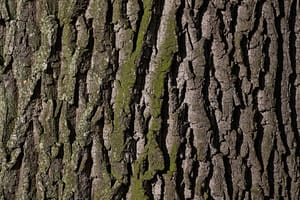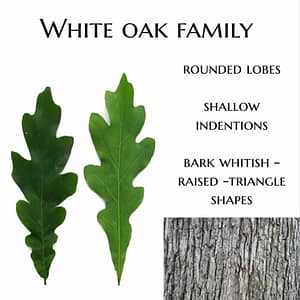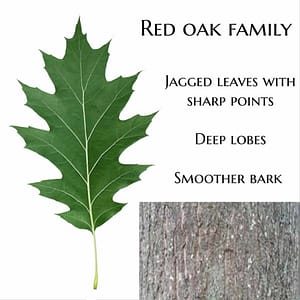Oak Identification
Oaks are among the most iconic and diverse trees in North America, with a wide range of species adapted to various climates and environments. To truly appreciate the beauty and ecological significance of these magnificent trees, it is essential to understand the key characteristics that set apart the different types of oaks.
In this oak identification guide, we will explore the distinguishing features of some of the most common and notable oak species, empowering you to identify and appreciate them in their natural habitats.
Red Oaks
Red Oaks (Quercus rubra): Native to eastern and central North America, Red Oaks are characterized by their distinct lobed leaves, which typically have 7 to 11 pointed lobes and bristle-tipped teeth. The leaves are dark green and glossy above, with a paler underside.
In autumn, the leaves turn a brilliant red or reddish-brown before falling. Red Oak acorns mature in two years and have a shallow, saucer-like cup that covers about one-fourth of the nut.
White Oaks
White Oaks (Quercus alba): Found throughout the eastern United States, White Oaks have leaves with rounded lobes, lacking the bristle-tipped teeth of Red Oaks. The leaves are usually 5 to 9 lobed and are a dull blue-green above and pale below. In autumn, they turn a rich brown or red-purple. White Oak acorns mature in one year and have a deep, bowl-shaped cup that covers about one-third of the nut.
Black Oaks
Black Oaks (Quercus velutina): Common in the eastern and central United States, Black Oaks have leaves with 7 to 9 lobes, each lobe ending in one to three bristle-tipped teeth. The leaves are dark green and glossy above, with a yellowish-brown, velvety underside. In autumn, they turn yellowish-brown or dull red. Black Oak acorns mature in two years and have a deep, bowl-shaped cup that covers about half of the nut.
Another type of Black Oak is the California Black Oak (Quercus kelloggi) which is native to the western United States, particularly California. This species is adapted to drier climates and is known for its deeply lobed leaves and acorns that mature in two years.
Live Oaks
Live Oaks (Quercus virginiana): Native to the coastal regions of the southeastern United States, Live Oaks are evergreen, retaining their leaves throughout the year. The leaves are simple, alternate, and leathery, with an oblong or elliptical shape. They are dark green and glossy above, with a pale grayish underside. Live Oak acorns mature in one year and have a deep, turbinate (top-shaped) cup that covers about one-third of the nut.
Bur Oaks
Bur Oaks (Quercus macrocarpa): Found in the central and eastern United States, Bur Oaks have the largest acorns of any North American oak species. The leaves are deeply lobed, with 5 to 7 lobes, and are dark green above and grayish-green beneath. In autumn, they turn yellowish-brown. Bur Oak acorns mature in one year and have a deep, fringed cup that covers about half to three-quarters of the nut.



Oak Identification Broken Down
To identify oaks in the field, pay close attention to leaf shape, lobe structure, and the presence or absence of bristle-tipped teeth.
Additionally, note the acorn maturation time and the shape and coverage of the acorn cup. By familiarizing yourself with these key characteristics, you will be well-equipped to recognize and appreciate the diverse array of oak species that grace our landscapes.
Leaf Shape
Oak leaves come in a variety of shapes, ranging from simple and unlobed to deeply lobed. Some common leaf shapes include:
Oblong or elliptical (as seen in Live Oaks)
Deeply lobed with rounded lobes (as seen in White Oaks)
Lobed with pointed or bristle-tipped lobes (as seen in Red Oaks and Black Oaks)
By observing the overall shape of the leaf, you can begin to narrow down the potential oak species you are looking at.
Lobe Structure
The lobes of oak leaves can provide valuable clues to the tree's identity. Consider the following:
Number of lobes
Count the number of lobes on a leaf. For example, White Oaks typically have 5 to 9 lobes, while Red Oaks have 7 to 11 lobes.
Depth of sinuses (the indentations between lobes): Some oaks, like the White Oak, have deep sinuses that extend close to the midrib, while others, like the Bur Oak, have more shallow sinuses.
Presence or Absence of Bristle-Tipped Teeth:
Look closely at the edges of the lobes or the leaf margins.
Bristle-tipped teeth:
Species like Red Oaks and Black Oaks have small, tooth-like projections at the end of each lobe, tipped with a fine bristle.
Smooth or rounded margins:
Species like White Oaks and Live Oaks have smooth or wavy margins without bristle-tipped teeth.
The presence or absence of these bristle-tipped teeth can be a key factor in distinguishing between certain oak species.
Acorn Maturation Time
Oaks can be divided into two main groups based on the time it takes for their acorns to mature.
White Oaks: Acorns mature in one year. This group includes species like White Oaks, Live Oaks, and Bur Oaks.
Red Oaks: Acorns mature in two years. This group includes species like Red Oaks and Black Oaks.
Knowing the acorn maturation time can help you rule out certain species when identifying oaks.
Acorn Cup Shape and Coverage
The shape of the acorn cup and the extent to which it covers the nut can also be diagnostic.
Cup shape
Some cups are deep and bowl-shaped (like in White Oaks and Black Oaks), while others are more shallow and saucer-like (like in Red Oaks). Live Oaks have a unique turbinate (top-shaped) cup.
Cup coverage
The proportion of the nut covered by the cup varies between species. For example, the cup of a Bur Oak acorn covers about half to three-quarters of the nut, while the cup of a White Oak acorn only covers about one-third of the nut.
By examining the acorn cup shape and coverage, you can further refine your identification of the oak species.
Oaks Without Lobes
Willow oaks, water oaks, and other oaks without lobes belong to the red oak group. These species, along with other oaks without lobes such as laurel oak and shingle oak, are characterized by their smooth, unlobed leaves. This distinguishes them from the more familiar lobed oak leaves seen on species like white oak or red oak.
Identifying these smooth-leaved oaks can be challenging due to their similar appearances. Willow oaks have long, narrow leaves resembling those of willow trees. Water oaks possess variable leaf shapes, often wider at the tip and narrower at the base.
Laurel oaks feature oblong leaves with a glossy surface. Bark characteristics, acorn size and shape, and overall tree form can also aid in identification. Observing the habitat where the tree grows can provide additional clues, as water oaks prefer moist areas while willow oaks tolerate a wider range of conditions.
Shingle oak Quercus imbricaria can be identified by its distinctive leaves, which are oblong to elliptical in shape and have smooth, untoothed edges. These leaves are dark green and glossy on the upper surface, while the undersides are paler and slightly hairy.
The bark of mature shingle oaks is dark gray to brown and develops shallow furrows and narrow ridges as the tree ages. The tree's acorns are relatively small, typically measuring about 1/2 inch in length, and are enclosed by a thin, saucer-like cap that covers about one-third of the nut. The tree's name comes from its historical use, as its wood was often split into wood for shingles.
Conclusion
When identifying oaks in the field, it's essential to consider a combination of these characteristics rather than relying on a single trait. Additionally, keep in mind that there can be some variation within a species due to factors like age, environment, and genetics.
Beyond their beauty and majesty, oaks play a vital role in the ecosystems they inhabit, providing food and shelter for countless species of wildlife. As you embark on your journey to discover the world of oaks, remember to observe with a keen eye, a curious mind, and a deep respect for the intricate web of life that these trees support.
By familiarizing yourself with these key identification features and observing them closely in the field, you'll be well on your way to confidently identifying the various oak species you encounter. As you gain experience, you'll develop a keen eye for the subtle differences that set each species apart and a deeper appreciation for the incredible diversity of oaks in our natural world.


